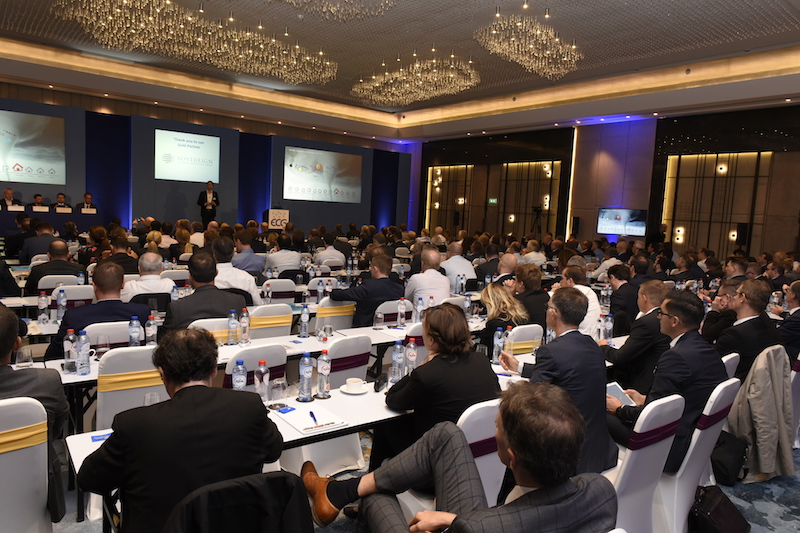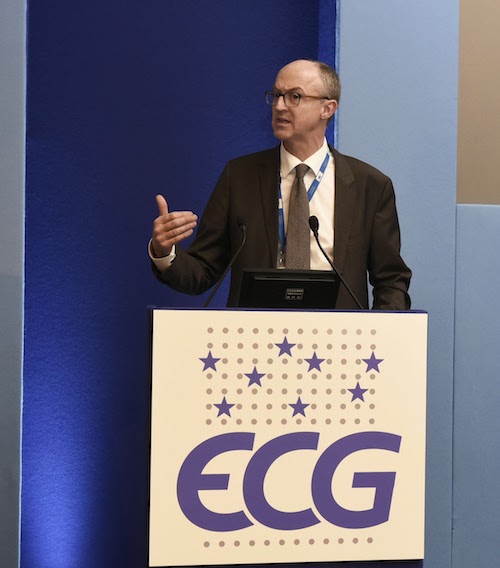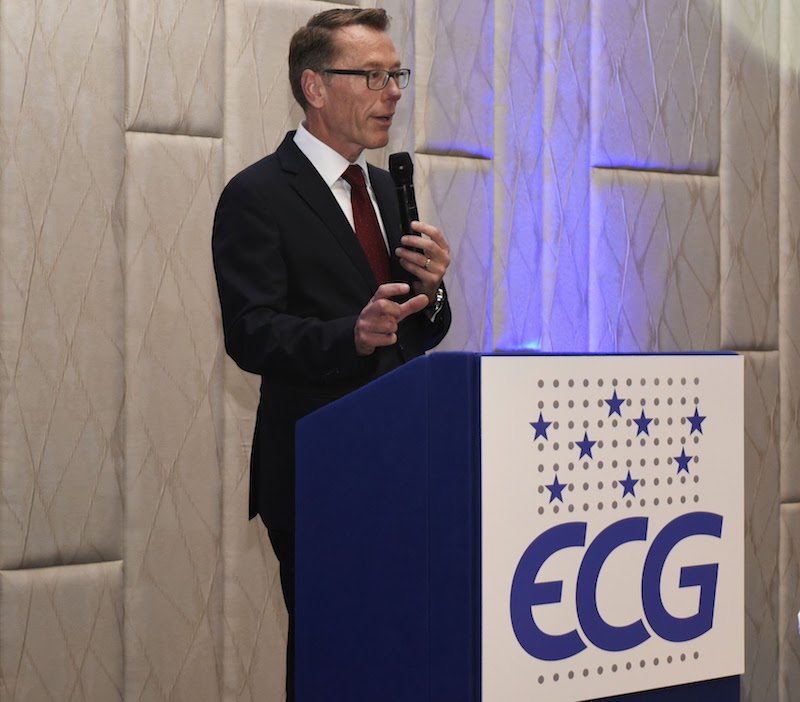 Whether it has been politics, the economy, ‘Dieselgate’, collapsing German rail tunnels or adverse weather, the European transport sector has its fair share to deal with this year – at a time which also appears to mark the end to a recent cyclical high in new vehicle registrations, at least for some markets.
Whether it has been politics, the economy, ‘Dieselgate’, collapsing German rail tunnels or adverse weather, the European transport sector has its fair share to deal with this year – at a time which also appears to mark the end to a recent cyclical high in new vehicle registrations, at least for some markets.
At the same time, the industry is facing disruption from the technology being built into the vehicle and used to produce, protect and deliver it. Trends in mobility forecast some seismic shifts in vehicle use but advances in telematics and autonomous driving promise to have an impact on the way vehicles are delivered. The question for the outbound sector at this year’s ECG conference in Brussels, Belgium, was just what all this means for the future of their business.
Political turmoil was a central theme at this year’s meeting but, for some of the more obvious examples that are threatening business at the moment, a lack of clarity meant that uncertainty was being fed by ill-informed speculation.
Brexit is a case in point. Recent figures from the UK’s Office of National Statistics show that investment in the UK by overseas companies and individuals fell from a £120 billion ($158 billion) surplus in the first half of 2016 to a £25 billion deficit over the same period in 2017. According to separate figures from business analyst PwC, net investment in the UK has plunged by more than 60% in 2017 and there was a 9% decline in new vehicle registrations in September compared to the same period last year – marking the first decline in UK automotive sector since 2009.
However, fears that a ‘hard Brexit’ could lead to major disruption for the car industry and the transport providers supporting it are, at the moment, largely down to scaremongering fed by uncertainty, according to the ECG’s executive director, Mike Sturgeon, who does not see the situation becoming much clearer anytime soon.
“It is true to say that a lot of our members are concerned about what it will mean, especially those [in the UK], but no one can give them any answers and it is going to be some months before anyone can,” said Sturgeon.
Pressed on whether a hard Brexit could lead to congestion at the UK border because of more restrictive customs controls, Sturgeon said this was just negative speculation. He brought the conference themes of politics and digitalisation into focus by suggesting that there were already digital solutions to any consequences for cross-border traffic from the current political turmoil.
“The technology is there to ensure that there are no border delays, it could all be paperless and digital,” he said. “[Customs] only has to stop people they want to check or have a suspicion about.”
Sturgeon said digital customs borders for freight could exist to ensure security and that anything to the contrary was ominous speculation. “People came out with these things before the [referendum] vote; they weren’t informed then and they are not well informed now.”
It was a similar scenario for the situation in Spain’s Catalonia region, which is seeking independence with or without the Spanish government’s consent. On the morning of the conference (October 20th) it was announced that 700-plus businesses from sectors including banking, infrastructure and telecoms had moved their head offices out of the region fearing disruption. Catalonia represents around 19% of Spain’s overall GDP and last week Spain revised its growth figure for next year down to 2.3% (from 2.6%) based on the political uncertainty in the region. Pro-independence strike action has already hit the transport sector and the automotive industry there, with port and plant activity affected.
According to Christoph Stürmer, global lead analyst at PwC Autofacts, irrespective of what the ultimate consequence of the situation in Spain will be, it is the lack of security that is affecting investment. However, Spain’s automotive market is in growth mode. New car registrations were up 4.6% in September compared to the same month last year and Stürmer said that as long as economic freedoms were not impinged, business pragmatism in the automotive sector would keep businesses where they were.
Contention over cabotageEuropean transport legislation was another area of contention at the conference, especially in terms of cabotage – the transport of goods (including finished vehicles) between two points within one EU member state by a transport operator registered in a different member state.

Eddy Liégeois, head of unit land transport at the EC’s Directorate-General for Mobility and Transport, said the department was looking to introduce new rules for cabotage in the EU, though he was careful to qualify that “given the current atmosphere in road transport”, rather than a liberalisation of current restrictions this would be more of a simplification.
Cabotage is a difficult issue at a European level because, as Sturgeon pointed out, Eastern European operators tend to prefer a more relaxed approach while Western European operators tend to ask for tighter rules.
Currently, operations by a transport company from another state are restricted to three movements in seven days, something Liégeois said was difficult to enforce because the number of operations could not currently be checked with any certainty.
“What we propose is that the foreign company could carry out as many cabotage operations as it needed for five days in member states,” he said.
Given that cabotage accounts for 2% of overall transport activity in Europe, Liégeois suggested the simplification of the rules would have no major impact on business, though he recognised how sensitive the issue was.
The five-day proposal was immediately contested, however, by Marc Billiet, head of EU goods transport at the International Road Transport Union (IRU). Billiet said the IRU was looking for a simplification of EC rules on goods movements overall, along with more efficient enforcement of them and no extra barriers – but on the cabotage issue, he said the IRU could not agree.
“Seven days is fine [but] we feel that the Commission should have done more to improve the enforcement,” he said, adding that there needed to be more clarity in the definitions.
“There have been attempts made but, for example, the Commission has still not defined when the cabotage period starts,” Billiet pointed out. “It still does not ask for the evidence of cabotage to be made available on board the vehicle.”
He said electronic documents could be introduced as potential proof but currently electronic transport and liability consignment notes (eCMRs) did not contain all of the elements that had been listed in the proposal. The slow take-up of eCMR is another problem in this regard.
“We also feel that more should be done to advance the introduction of the smart tachograph, which could open more opportunities for efficient enforcement,” said Billiet.
DieselgateThe cabotage rule was just one of seven land transport-related proposals from the EC introduced by Liégeois. Reducing carbon emissions was another – and something that had particular resonance at this year’s ECG conference in the wake of the diesel scandal, which has repercussions both for vehicle sales and the trucks used to move them.
Christoph Stürmer at PwC said diesel had become a politically incorrect word in very few months.
“We get calls from banks or leasing companies every other week saying that they have hundreds of thousands of diesel cars in stock and asking: should they be worried? The answer is yes, they should be,” he said, adding that the used Euro 5 diesel car was almost “a toxic asset” now.
The problem with that is the impact on residual value of diesel vehicles coming off their first lease or financing periods.
Stürmer said some production schedules were not as flexible as required and the industry was running into a structural oversupply of diesel vehicles as private buyers, who account for 80% of the market, hesitated.
“It is an interesting situation and we are waiting for negative announcements from the OEMs every day,” said Stürmer.
Cleaner without the costBeyond those concerns of oversupply, the EU has priorities to clean up the industry. Liégeois said reducing climate impact was a main challenge, with the road sector responsible for almost a quarter of Europe’s greenhouse gas emissions. The EC’s road initiatives are aimed at contributing to Paris Agreement goals and reducing carbon emissions by 2030.
Clement Chandon, gas business development manager at truckmaker Iveco, said that ‘Dieselgate’ was a reminder that pollution was an issue, and that transporters and shippers were asking his company to come up with a solution now that would not affect the cost-effectiveness of road haulage. Gas-powered trucks offered the potential to do that and Chandon said Iveco was already the market leader in compressed natural gas (CNG) trucks, based on more than 20 years of investment and research. However, it was important for gas to be a realistic alternative that matched diesel on cost of ownership.
“No one would accept less than what a diesel truck can do today,” said Chandon. “Diesel is dominating the world because of flexibility and cost.”
According to Chandon, 90% of the trucks on European roads today could run on renewable fuel with the same reliability.
Delegates had a chance to see this potential in the form of a liquefied natural gas (LNG) Iveco Stralis truck combined with a car transporter unit supplied by Rolfo being shown at he evenet. It is due to go into service next year.
Iveco already has 150 LNG trucks providing logistics services within the company and 300 orders on its books. Chandon said it would be supplying 650 LNG trucks for its logistics partners by next year.
Digital truckingWhat carmakers and their outbound transport providers also need to deal with as soon as possible is the digitalisation of the supply chain.
The ECG has established a working group on digitalisation and is looking to establish technical specifications on telematics, standards for electronic documents and e-Gate technology akin to Uber to manage truck arrival slots for pick-up and delivery.
All three are crucial to taking waste out of the outbound delivery process. Steven Quaak, head of strategy for Daimler Fleetboard – the OEM’s digital services division for logistics – explained that the truck was an expensive asset but was only running for 35% of the time. For 50% of the time, it was parked up and when it was not being loaded, it was often stuck in traffic jams, at borders or outside yards. He also said one in five trucks in Europe were running empty.
Off the back of an innovation process that gathers ideas for prototype testing from Daimler’s truck users – the Fleetboard Innovation Hub – the company has already introduced a number of ideas to make the most of the truck asset. They include NxtLoad, a tool the company is now piloting that brings together load board (or freight board) information in one place. Load boards are online matching systems that allow shippers and freight brokers to post loads. They also allow carriers to post their free equipment.
Quaak said there were 60 different platforms in the US but NxtLoad could bring all the information together in one glance. The company also has a Fleetboard Manager app which brings together all the different data sources that fleet operators have on their trucks that are kept across different systems.
 Böhme: VW's digital truck management platform, Rio, includes predictive maintenance services and over-the-air updates on vehicle performance
Böhme: VW's digital truck management platform, Rio, includes predictive maintenance services and over-the-air updates on vehicle performanceVolkswagen Truck and Bus also has some digital services for its customers aimed at making the most of the truck asset. Rabea Böhme, senior manager of business development at the company’s digital truck management platform, called Rio, said these included predictive maintenance services using telematics data from the vehicle, so that parts could be changed ahead of their failure time, minimising downtime. The service also provides over-the-air updates on truck performance.
The company is helping smaller logistics providers that may lack their own transport management system (TMS) with access to the Rio platform, which hosts TMS software they can use. Böhme said the aim was to help customers become digitalised more quickly without the need for huge overhaul or investment. It is also providing an ETA calculator by the end of this year and has started installing its Rio-Box in other brands of trucks. The cloud-based telematics operating system connects all participants in a supply chain, independent of vehicle brand or the telematics system used, to show truck locations and availability.
Tapping the exponentialThe pace of development in this sort of technology is set to change beyond recognition, according to Märtha Rehnberg, co-founder and partner at technology innovator DareDisrupt. She gave delegates an analogy for how important it was not to lag behind fast-paced developments in digital technology driven by the exponential acceleration of computing power, telling delegates to picture themselves at the top of a football stadium looking at a tap in the middle that was dripping one millimetre drops of water every minute exponentially. She then asked at what point they would run for their lives to avoid drowning. The answer was 44 minutes but the important question was when in that situation you would notice the increase that was about to submerge you. ‘Too late’ was the answer.
“Most of the time it is just a ridiculous pool in the middle but all the new technologies that are building on digitalisation are developing like this,” said Rehnberg. “They look ridiculous in the beginning and we will forget them, only to be surprised in the 42nd minute.”
Artificial intelligence, the networked 3D printing of flexible solar panels and peer-to-peer trading using blockchain technology were just some examples of the nascent but deceptive creep of new technology. Rehnburg’s message was that companies needed to plan because negotiating ‘the Kodak moment’ – when the switch to digital imaging happened and changed everything – was about leadership and management.
“The exponential acceleration of computing is touching all industries and yours is affected – and there is nothing you can do to circumvent it,” she said.
This was a timely warning for the finished vehicle sector. Harmut Haubrich, director of FVL Systems at systems and IT firm Inform, revealed that the finished vehicle sector was not keeping pace with IT developments, according to a company survey involving 100 OEMs and logistics providers. The Inform survey found the average age of information technology more than 11 years old was increasing while those same companies were anticipating major technological changes affecting their business in the next five years, including more sophisticated telematics and autonomous vehicles for yard operations.
Alina-Stefania Ujupan, member of the cabinet of Mariya Gabriel, the European commissioner for digital economy and society, said the digitisation of transport was one of the most important trends affecting the logistics industry and that the future was inconceivable without it.
 Göbel: increasing participation by vehicle OEMs
Göbel: increasing participation by vehicle OEMsUjupan emphasised the impact that connected and autonomous vehicles would have on the whole finished vehicle sector and pointed to the opportunities that lay ahead through such innovations as multi-brand truck platooning, before welcoming the efforts being made by different brands to collaborate on bringing these opportunities to fruition.
Ujupan also highlighted that there were a number of working groups already active on C-ITS [Cooperative Intelligent Transport Systems], which aims to allow road users and traffic managers to share information and use it to coordinate their actions, and on autonomous driving. She said the Commission was taking several policy measures to support the industry and its transition to automated driving, including the set-up of cross-border testing initiatives, research on autonomous driving and the provision of the necessary legal framework.
Important in this transition was the free flow of non-personal data, she added. Ujupan said the Commission had proposed the removal of all disproportionate restrictions on the movement of data across EU member states and IT systems used there. She also pointed to research from professional services company Deloitte which showed that taking away obstacles to data mobility was expected to generate additional growth of up to 4% GDP by 2020.
The interoperability and continuity of services across borders in Europe was a priority, according to Ujupan, who said the Commission had a focus on transport technology being just that and providing a good quality of service.
One of the initiatives the Commission has already agreed to is the launch of cross-border corridor testing of interoperable transport systems involving a number of member states. It is calling for 5G testing for autonomous driving backed with a €5m ($5.8m) investment for companies that wanted to promote it along the main transport lanes connecting the EU.
As the finished vehicle logistics sector in Europe moves forward to embrace the changes in policy and process disruption that technology is bringing, ECG president Wolfgang Göbel was keen to stress that the association was doing its bit to support the industry.
Along with its working group on digitalisation, it has established a new group looking at telematics and connectivity and is working on digitalisation with Odette International, the pan-European collaboration and services platform for the automotive industry. It has also established a working group on quality, looking at electric vehicles and health and safety; and one on capacity, which currently involves a project with Spanish carmaker Seat on a virtual yard designed to reduce vehicle inventory following factory release.
Göbel said the ECG working groups had seen an increase in participation from the OEMs and a willingness to work together.
“The difference to previous meetings is where once, problematic issues were thrown on the table and it was someone else’s job to solve them, now the OEMs and LSPs are discussing together with ECG and are prepared to work together with us; it is a remarkable change,” he said.


























![Global[1]](https://d3n5uof8vony13.cloudfront.net/Pictures/web/a/d/s/global1_726550.svgz)









